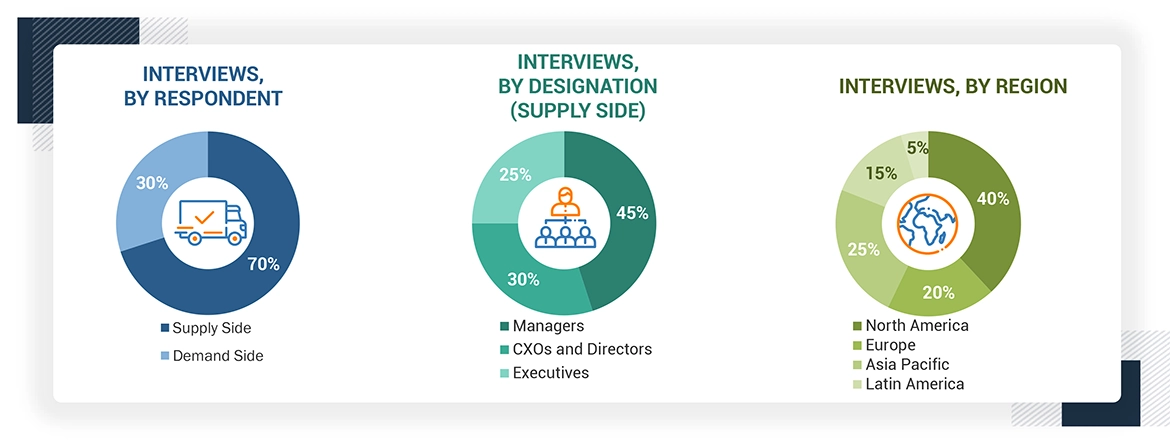This research study involved the extensive use of secondary sources, directories, and databases to identify and collect valuable information for the analysis of the global transfection technologies market. In-depth interviews were conducted with various primary respondents, including key industry participants, subject-matter experts (SMEs), C-level executives of key market players, and industry consultants, to obtain and verify critical qualitative and quantitative information and assess the growth prospects of the market. The global market size estimated through secondary research was then triangulated with inputs from primary research to arrive at the final market size.
Secondary Research
Secondary research was used mainly to identify and collect information for the extensive, technical, market-oriented, and commercial study of the transfection technologies market. The secondary sources used for this study include US Food and Drug Administration (FDA), European Federation of Pharmaceutical Industries and Associations (EFPIA), Organisation for Economic Co-operation and Development (OECD), Latin American Society for Developmental Biology, International Society for Cell & Gene Therapy (ISCT), American Society of Gene & Cell Therapy (ASGCT), World Health Organization (WHO), Centers for Disease Control and Prevention (CDC), South African Medical Research Council (SAMRC), National Institute for Health and Care Research (NIHR), International Federation of Pharmaceutical Manufacturers & Associations (IFPMA), National Institutes of Health (NIH), European Commission, and European Pharmaceutical Review. Secondary sources include corporate and regulatory filings (such as annual reports, SEC filings, investor presentations, and financial statements), business magazines, research journals, press releases, articles & blogs. These sources were also used to obtain key information about major players, market classification, and segmentation according to industry trends, regional/country-level markets, market developments, and technology perspectives.
Primary Research
Extensive primary research was conducted after acquiring basic knowledge about the global transfection technologies market scenario through secondary research. Several primary interviews were conducted with market experts from the demand side, such as pharmaceutical and biopharmaceutical companies, CROs, CDMOs, and academic & research institutes, and experts from the supply side, such as C-level and D-level executives, product managers, marketing & sales managers of key manufacturers, distributors, and channel partners. These interviews were conducted across five major regions, including the Asia Pacific, North America, Europe, Latin America, and the Middle East & Africa. Approximately 70% and 30% of the primary interviews were conducted with supply-side and demand-side participants, respectively. This primary data was collected through questionnaires, e-mails, online surveys, personal interviews, and telephonic interviews.
The following is a breakdown of the primary respondents:

To know about the assumptions considered for the study, download the pdf brochure
Market Size Estimation
Both top-down and bottom-up approaches were used to estimate and validate the total size of the transfection technologies market. These methods were also used extensively to estimate the size of various subsegments in the market. The research methodology used to estimate the market size includes the following:
Bottom-up Approach
Top-down Approach
Data Triangulation
To complete the overall market engineering process and arrive at the exact statistics for all segments and subsegments, data triangulation and market breakdown procedures were employed, wherever applicable. The data was triangulated by studying various factors and trends from both the demand and supply sides.
Market Definition
Transfection is the process of deliberately introducing naked or purified nucleic acids (including DNA, RNA, or proteins) into eukaryotic cells. Transfection is a powerful tool that helps in the study of gene functions and can be achieved using biochemical, physical, and viral vector methods. Transfection technologies have been used in life science research and have been exploited for therapeutic delivery like gene therapy. This gene transfer technology enables the study of gene function and protein expression in a cellular environment.
The scope of the report includes FDA-approved transfection technologies products that are used for the transfection of nucleic acids into eukaryotic cells with the help of innovative method where the transfection technologies are intended to deliver DNA, RNA, or proteins for biomedical research, therapeutic delivery, and protein production.
Stakeholders
-
Transfection products manufacturing companies
-
Pharmaceutical & Biopharmaceutical Companies
-
Chemical Companies
-
Biopharmaceutical Companies
-
Contract Research Organizations (CROs)
-
Contract Development and Manufacturing Organizations (CDMOs)
-
Research Institutes and Universities
-
Venture Capitalists & Investors
-
Government Associations
Report Objectives
-
To define, describe, segment, and forecast the transfection technologies market by product type, method, application, end user, and region
-
To provide detailed information about the major factors (such as drivers, restraints, opportunities, and challenges) influencing the market growth
-
To strategically analyze micromarkets1 with respect to individual growth trends, prospects, and contributions to the overall market
-
To analyze market opportunities for stakeholders and provide details of the competitive landscape for key players
-
To forecast the size of the transfection technologies market in five main regions: North America, Europe, Asia Pacific, Latin America, and the Middle East & Africa, along with their respective key countries
-
To profile the key players in the transfection technologies market and comprehensively analyze their core competencies2 and market shares
-
To track and analyze competitive developments, such as product launches, acquisitions, expansions, collaborations, agreements, and partnerships of the leading players in the transfection technologies market
-
To benchmark players within the transfection technologies market using the ‘Competitive Leadership Mapping’ framework, which analyzes market players based on various parameters, including product portfolio, geographic reach, and market share/rank



Growth opportunities and latent adjacency in Transfection Technologies Market